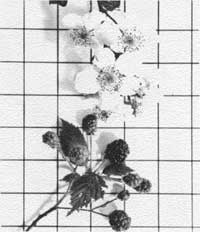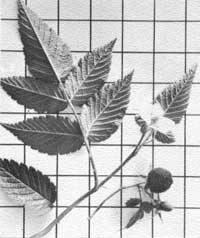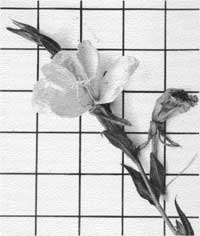|
BLACKBERRY
Rubus penetrans—Rose Family (Rosaceae)
|
|
The common blackberry is known to most of you. It has
white flowers and berries that have an excellent flavor when ripe. Its
vines have formed bramble thickets in many sections of the park,
especially in the vicinity of Kilauea.
The blackberry was probably brought to the Hawaiian
Islands before 1900, and is now well established on many of the islands.
Because of its hardiness it presents a continuous control problem if the
native cover is to be protected. Many blackberries cross readily with
close relatives, forming hybrids which may not resemble the parent
forms.
|

(Inch squares on background)
|
|
OLAA OR THIMBLEBERRY
Rubus rosaefolius—Rose Family (Rosaceae)
|
|

(Inch squares on background)
|
In open grassy areas, as well as in the moist forest
of Kilauea, you may see a small shrub with white flowers and red berries
slightly resembling strawberries. These are thimbleberries and are
edible. This plant is a native of the Orient and was introduced to
practically all of the Hawaiian Islands with the exception of
Molokai.
A member of the rose family and a close relative of
the blackberry and the native Hawaiian raspberry, or akala, (page
10) the thimbleberry blooms and bears fruit during much of the year. You
can find it near the tree molds, about 2 miles from park
headquarters.
|
|
EVENING PRIMROSE
Oenothera striata—Evening Primrose Family (Onagraceae)
|
|
Along the roadsides in the Kilauea area you can see
plants bearing bright, sulphur-yellow flowers which turn orange-red upon
wilting. These South American evening primroses are close relatives of
the evening primroses native to many western National Parks. The evening
primrose found in Hawaii National Park may have escaped from garden
cultivation near Kilauea.
As the name indicates, these flowers bloom at night
and soon wilt upon being exposed to bright sunlight. The primroses are
pollinated by moths which have tongues long enough to reach the nectar
in the flower tube.
|

(Inch squares on background)
|
|
JERUSALEM CHERRY
Solanum pseudocapsicum—Nightshade Family (Solanaceae)
|
|

(Inch squares on background)
|
If you can take the beautiful drive up the slopes of
Mauna Loa, you will notice dense growths of a light-green plant up to 4
feet in height, especially beneath the koa trees. The Jerusalem cherry
received its name from the round berries the size of small cherries,
which are bright red when ripe. The flowers are small and white. The
Jerusalem cherry also grows on the dry slopes of Haleakala. It is a
native of the Old World, and was possibly introduced to Hawaii as an
ornamental garden plant.
The common potato is a member of the same family and
bears the same generic name, Solanum, as the Jerusalem cherry.
Some other species contain narcotics and some are poisonous.
|

